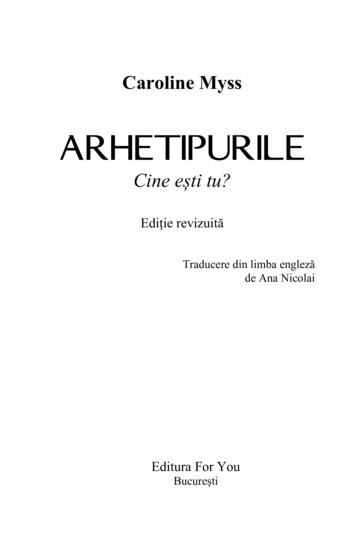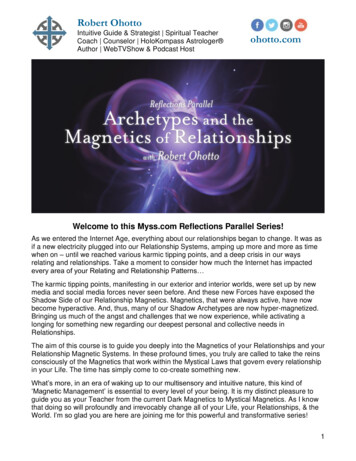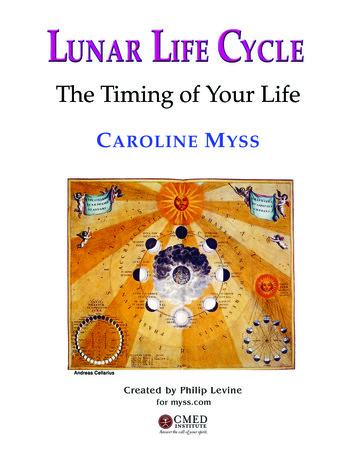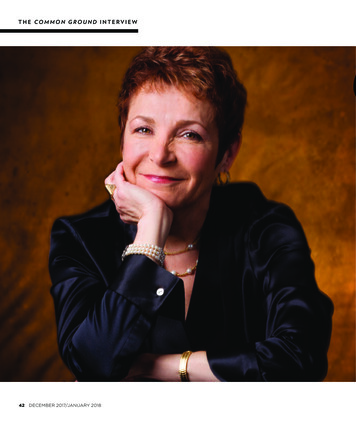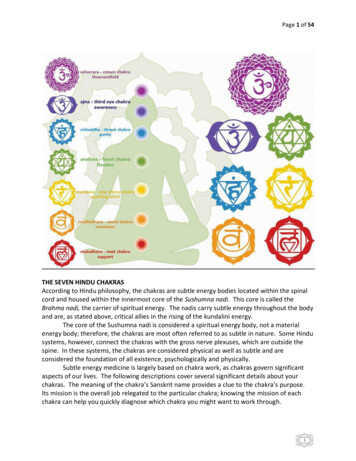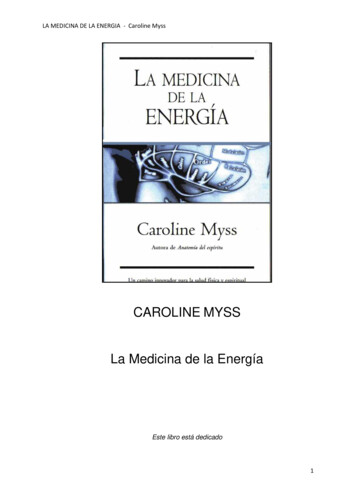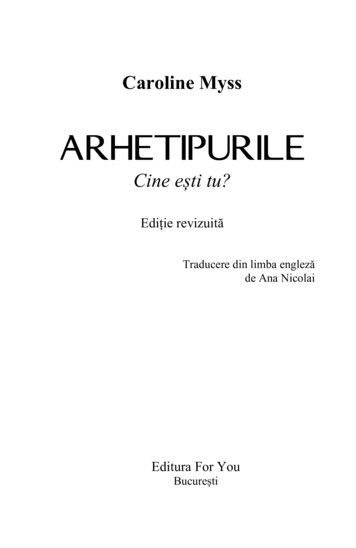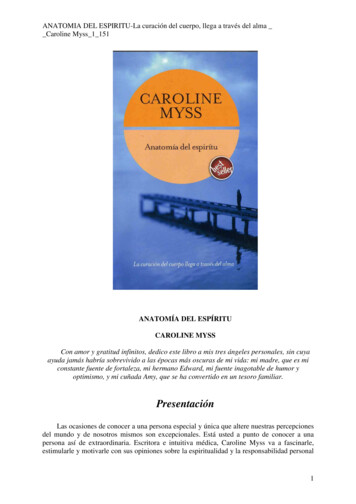
Transcription
Caroline myss archetype cards pdf
SKU: ARCHETYPECARD UPC: 9781401901844 Type: Oracle Cards Company: Hay House Author: Caroline Myss Theme: Psyche & Psychology thumbnail-desktop-prev-arrow thumbnail-desktop-next-arrow thumbnail-mobile-prev-arrow thumbnail-mobile-next-arrow Description Delivery & Returns On the Back of the DeckArchetypes are ancient,universal patterns of behavior that are embedded in what Carl Jung called the "collective unconscious". Caroline Myss has created a unique set of 74 Archetype Cards, each individually designed to provide the basic Light and Shadow Attributes of a different Archetype. The deck also contains 6 blank cards on which you can create your ownArchetypes.Included is an instruction booklet explaining how to use the cards to help determine which Archetypes are most active in your psyche, and how they can lead you to achieve greater insights into your life. The deck is suitable to be used by itself, in conjunction with Caroline's book Sacred Contracts, or with any of her workshops andseminars.Pack Includes: A 105 page guidebook and 80 card deck.Card Size: Approximately 9 x 12.5 cm (3.5 x 5"). About Caroline Myss American born Caroline Myss is a medical intuitive, mystic and author of a number of bestselling books, including Why People Don’t Heal and How They Can, Sacred Contracts: Awakening Your Divine Potential andAnatomy of the Spirit: The Seven Stages of Power and Healing.She initially started her career as a journalist and, after completing a Master’s degree in theology, she co-founded Stillpoint Publishing, where she led the editorial department. There she was responsible for producing books in the fields of holistic health and humanconsciousness.Caroline’s work as a medical intuitive began when she teamed up with C. Norman Shealy, a neurosurgeon, and began to do health readings of his patients. All the readings were done via a telephone and by only knowing the name and age of the patient, Caroline was able to produce profiles of their physical, psychological, emotional andfamily history.Her research led her own to develop the discipline of energy anatomy, which links emotional, psychological, physical and spiritual stress with diseases. Her work in this area eventually led to the publication of the book, The Creation of Health, in conjunction with Norman Shealy.Caroline and Norman developed an educational programto teach the principles of the Science of Medical Intuition and also fund research into the field. In 2003, Caroline created CMED (Caroline Myss Education), an educational institute with courses relating to personal development.Caroline’s books have been translated into numerous languages and are of universal appeal. She continues to teachworkshops, run seminars, speak on radio shows and produce audio recordings. UK 1st Class Royal Mail – Flat charge 3.10, or Free on orders over 40 Order by 3pm Monday - Friday (excluding public holidays) & goods leave that day. Delivery after dispatch is 1-3 working days. UK Special Delivery Royal Mail by 1pm next working day – from 8.60Order by 3pm Monday - Friday (excluding public holidays). Doesn’t deliver on public holidays or Saturdays. Friday orders delivered Monday, you will need to sign for the goods. The exact price is based upon weight of items. INTERNATIONAL DELIVERY We offer various delivery options depending on your location, these are all tracked options. Addyour items to the basket, and view your shipping options at the checkout to see pricing, plus approximate delivery times. Royal Mail to Europe 5-10 working days after dispatch - from 4.20 (2 kg max.) DHL to Europe from 1-2 days after dispatch - from 19.96. Royal Mail to Outside Europe 10-15 working days after dispatch - from 6.48 (2 kg max.)DHL to Outside Europe from 1-2 days after dispatch - from 25.00. Order by 3pm for Royal Mail and 12 midday (Monday – Friday) for DHL and DPD, for dispatch on that day (Excludes public holidays). Exact price and transit time based on combination of destination and weight of parcel. RETURNS INFORMATION We accept returns of unopened /unused products within 60 days, please refer to our FAQ page for more information on this. Related Products Customers Also Viewed For a detailed description of over 70 archetypes, click here. To help you understand and fulfill the terms of your Sacred Contract, you have been encoded with a set of 12 primary archetypes. Four of these are universalarchetypes related to survival: the Child, Victim, Prostitute, and Saboteur. We all have these because they are vital to our growth and functioning as adults. The other eight are drawn from the vast storehouse of archetypes dating back to the dawn of human history. They play valuable roles that relate to our work, our relationships with individuals andsociety, as well as to our spirituality, finances, values, and our highest potential. Awareness of archetypes dates back at least to the time of Plato, who called them Forms. Plato believed that these eternal Forms were reflected in material objects. The Form of Beauty, for example, is abstract and applies to all beautiful things; as different as theindividual manifestations of Beauty may be–a beautiful person, horse, or flower–the Form itself never changes. The great Swiss psychologist Carl Jung developed this idea further. For Jung, archetypes comprised psychological patterns derived from historical roles in life, such as the Mother, Child, Trickster, and Servant, as well as universal events orsituations, including Initiation or Death and Rebirth. Along with our individual personal unconscious, which is unique to each of us, Jung asserted, “there exists a second psychic system of a collective, universal, and impersonal nature that is identical in all individuals.” This collective unconscious, he believed, was inherited rather than developed, andwas composed mainly of archetypes. Although archetypes are impersonal patterns of influence that are both ancient and universal, they become personalized when they are a part of your individual psyche. Since your Sacred Contract is embodied in a support system of twelve archetypes, it is best to think of them as intimate companions. They providethe foundation for your personality, drives, feelings, beliefs, motivations, and actions. But archetypes are not passive entities floating around in the psyche like old family portraits hanging in a dusty corridor of your ancestral castle. They take an active role as guardians and inner allies, alerting you when you are in danger of falling into destructive or“shadow” behavior. The Saboteur, for instance, warns you when you are in a situation in which you tend to sabotage your own best interests. Once you learn to recognize such a pattern, instead of ignoring it or denying its presence, it becomes your friend and can help you avoid selling out. The Shadow All archetypes have “shadow” manifestations aswell as positive aspects. The shadow has power precisely because it remains in the dark; we tend to deny its presence in us because we consider it unacceptable. Only when we face and acknowledge the shadow’s presence can we neutralize its potential negative impact on us. The Rebel archetype, for instance, can be a powerful force leading us toreject illegitimate authority and strike out on a bold new path of action. (Samuel Adams, Elizabeth Cady Stanton, Gandhi, and Martin Luther King, Jr., all had powerful Rebel archetypes.) But if we let our awareness lapse, the archetype’s shadow aspect can induce us to rebel against legitimate leaders, or to fall in love with the image and trappings ofrebellion (think of the rebellious angels in Jewish, Christian, and Muslim lore). Likewise, the Queen archetype can help you assert your power, take charge of situations, delegate authority, and act with benevolence. But the shadow Queen may run around barking out orders, making impossible demands, and cutting off heads! Once you learn torecognize the difference between the two responses — and their common source — you can harness the Queen’s constructive power while mitigating her shadow wrath. The first step in learning to work with your archetypes to interpret your Sacred Contract is to determine which 12 archetypes make up your support team. Next: Determining YourArchetypes » The archetypes listed here in boldface type are just a few of the many ancient patterns that exist in human consciousness. Many additional archetypes that are closely related are mentioned in parentheses, such as Hermit (found under Mystic), Therapist (under Healer), or Pirate (under Rebel). Please read through the entire list, lookingat all the archetypes in parentheses, before assuming that the one you’re looking for isn’t here. Naturally, it’s impossible to list all the hundreds of archetypes that exist, but these are some of the most common, and include just about all that are mentioned in my book, CD, or tape of Sacred Contracts. If you feel that you have an archetype that isn’tfound here, please do not hesitate to give it careful consideration, and feel free to include it in your support team. Remember that all archetypes are essentially neutral and manifest in both light and shadow attributes. Accordingly, I have tried to include both sets of attributes for each listing, along with cues to help you determine whether a givenarchetype may be part of your lifelong support team of twelve. To help you further, I’ve listed some examples of each archetype as embodied in popular film, fiction, drama, and the world’s religions and mythologies. In evaluating whether an archetype is part of your intimate group, pay special attention to whether you can perceive a pattern ofinfluence throughout your history, rather than only isolated or recent incidents. Never evaluate your connection to an archetype only by obvious markers. You have to stretch your imagination and burrow into yourself to discover your life patterns, lessons, and gifts. This inner knowledge does not surface easily. Addict (Conspicuous Consumer,Glutton, Workaholic–see also Gambler) Every one of us is touched by the Addict archetype. The only question is how much of our lives is consumed by it. Besides the usual suspects–drugs, alcohol, food, and sex–one can be addicted to work, sports, television, exercise, computer games, spiritual practice, negative attitudes, and the kinds of thrills thatbring on adrenaline rushes. In its positive aspect, this archetype helps you recognize when an outside substance, habit, relationship, or any expression of life has more authority over your will power than does your inner spirit. Confronting addiction and breaking the hold that a pattern or substance has on you can impart great strength to your psyche.Discovering the empowerment that comes with perseverance has a life-long impact, becoming a reference point for what you are able to accomplish. In the words of one former alcoholic, “I know now that if I can quit drinking, I can do anything.” From a symbolic perspective, the shadow aspect of the Addict represents a struggle with will power andthe absence of self-control. People who are extremely intellectual or emotional frequently have a close link to this archetype, because they struggle to balance these powers. Without this internal balance, the will may give up its power to an external substance that exerts authority, providing shadow order to your life. The shadow Addict compromisesyour integrity and honesty. Many addicts, for example, steal as a means of supporting their habit. In evaluating your connection to the Addict, review how many of your life’s challenges concern an external substance or a consistent, domineering pattern of trying to maintain order in your life. Although that challenge is a part of all of our lives, thedegree to which an addiction controls you and your lifestyle determines whether the Addict is part of your intimate family of twelve. For instance, you can be inconsistent in your exercise program yet quite disciplined in your spiritual practice. Needing a substance or practice or person so intensely or regularly that you compromise relationships,finances, integrity, character, or emotional and psychological well-being, however, indicates that you should look very seriously at this archetype as a possible choice. Films: Jack Lemmon and Lee Remick in Days of Wine and Roses (alcohol); Ben Stiller in Permanent Midnight (heroin); Dom de Luise in Fatso (food); Claire Bloom in The ChapmanReport (sex); Drama: A Long Day’s Journey into Night (morphine) by Eugene O’Neill Fiction: Basketball Diaries (heroin) by Jim Carroll; Under the Volcano (mescal) by Malcolm Lowry. Religion/Myth: Soma (Vedic god of intoxication, as well as the intoxicating drink itself and the plant from which it is made); Tantalus (a son of Zeus and king of Sipylosin Greece, he was invited to share the food of the gods but abused the honor and was punished by being “tantalized” for all eternity by food and drink he could not reach). Advocate (Attorney, Defender, Legislator, Lobbyist, Environmentalist) Coming to the defense of others is one manifestation of what Ram Dass calls “Compassion in Action.” TheAdvocate embodies a sense of life-long devotion to championing the rights of others in the public arena. People who relate to this archetype have recognized early on a passion to transform social concerns, specifically in behalf of others. Symbolically, they are dedicated to inspiring the empowerment of groups or causes that are unable to beempowered on their own. By comparison, archetypes such as the Hermit are clearly more personal and lack the Advocate’s fire for furthering social change. The Advocate needs public expression, even if only through writing or artwork. The shadow Advocate manifests in false or negative causes or in committing to causes for personal gain. Inevaluting your connection with this archetype, you should ask yourself how much of your life is dedicated to social causes and a willingness to take action. Films: Paul Newman in The Verdict; Spencer Tracy in Inherit the Wind; Julia Roberts in The Pelican Brief and Erin Brockovich; Robert Duvall in the Godfather trilogy (shadow). Television: PerryMason; L.A. Law; The Practice. Fiction: The Devil and Daniel Webster by Stephen Vincent Benet Fairy Tales: Puss in Boots. Religion/Myth: David (in the Hebrew Bible, the Jewish champion who slew the much larger Goliath); Hakuim (a pre-Islamic deity of southern Arabia who administers justice and oversees arbitration). Alchemist (Wizard, Magician,Scientist, Inventor–see also Visionary) These archetypes share the common trait of converting some form of matter into an altered expression of itself. The Wizard and Magician produce results outside the ordinary rules of life, whether causing people to fall in love or objects to disappear. Whereas a Wizard is associated with supernatural powers, theMagician tends to be seen more as an entertainer. The Alchemist is associated with vain attempts to turn base metals into gold, but in its highest manifestation it seeks complete spiritual transformation. You may identify with this archetype if you are interested in a path of spiritual development that is aligned to the mystery schools or study of thelaws of the universe. From this perspective, Nostradamus and Isaac Newton could both be classified as Alchemists. The shadow sides of these archetypes are found in the misuse of the power and knowledge that comes through them. Seduction and trickery brought about through magic and wizardry play on the desires of many people to transformtheir lives. For the Alchemist or Wizard to be one of your circle of twelve, it needs to be associated with your physical life in some significant way. Perhaps your work or living situation demands that you be especially inventive or interventionist on a regular basis. The shadow Wizard manifests either as the use of ingenuity for criminal or unethicalpurposes or as feelings of superiority based on high intellect. Films: Spencer Tracy in Edison the Man; Greer Garson in Madame Curie; Anthony Michael Hall as Bill Gates and Noah Wylie as Steve Jobs in Pirates of Silicon Valley (HBO video); Fred MacMurray (or Robin Williams) in The Absentminded Professor; Katharine Hepburn in The AfricanQueen; Jane Powell in Seven Brides for Seven Brothers; Jeff Goldblum in The Fly (shadow); Patrick Stewart and Ian McKellan (shadow) in X-Men. Fiction: The Alchemist by Paulo Coelho; The Mists of Avalon by Marion Z. Bradley; the Harry Potter series by J.K. Rowling; Alice’s Adventures in Wonderland by Lewis Carroll. Drama: The Miracle Worker byWilliam Gibson. Religion/Myth: Merlin (wizard and prophet involved in every phase of King Arthur’s life, from conception to rulership, who also counseled him as King); Cessair (magician who became the first Queen of Ireland); Tezcatlipoca (Aztec god of night and material things, whose black magic mirror made of obsidian or hematite reflected thethoughts and actions of humanity and could kill enemies); Paracelsus (16th-century Swiss alchemist and physician who described humans as the microcosmic reflection of the macrocosm); Hermes Trismegistus (Greek mythic figure who served as messenger of the gods, but who in later esoteric thought became a master of reality manipulation able totravel freely between the various realms and dimensions); Simon (Samaritan magician in the Book of Acts, 8:9-24, condemned by the apostle Peter for offering to buy the power of the Holy Spirit from him); Suyolak (gypsy wizard said to know all medicinal cures). Fairy Tales: Rumpelstiltskin (who spun straw into gold). Angel (FairyGodmother/Godfather) Angels exist in a category unto themselves because they are thought to be living beings of Light and messengers of the Divine. Almost every cultural and religious tradition on earth features angels of some description, including belief in a personal Guardian Angel in the Jewish, Christian, and Islamic traditions. Angels aretypically represented as winged beings who intervene in times of great need or for the purpose of delivering a message of guidance or instruction from God to humans. Even though you probably aren’t an actual Angel, you can acknowledge a strong connection to the angelic realm, as noted in people who have a dedication to representing thepresence of angels. Artists who paint their images, for example, authors who write about their interaction with humans, and those whose lives in some way provide a channel through which their presence is physically manifested exhibit a rapport with the angelic realm. Some people are also referred to as “angels” because of the loving and nurturingqualities of character that they embody. One may also play the role of a Fairy Godmother or Godfather by helping someone in need either anonymously or with no expectation of any return. The shadow side of this archetype manifests through people who make claims to be in touch with angelic guidance for the sake of control or ego enhancement, orwho act innocent or angelic to mislead others about their true nature. From a biblical perspective, the shadow Angel is frequently associated with Satan or Lucifer, but the Devil or Demon should also be considered as a unique archetype. Films: Herbert Marshall in The Enchanted Cottage; Charles Coburn in The More the Merrier; Aunt March to Amyin Little Women; the two angels in It’s A Wonderful Life; Marlon Brando in The Godfather trilogy (shadow); Danny Glover, Kevin Kline in Grand Canyon. Television: Touched by an Angel Fairy Tales: Glinda in The Wonderful Wizard of Oz by L. Frank Baum Religion/Myth: Angiris (Hindu angels who preside over sacrifices); Uriel (in rabbinic lore, theangel who wrestled with Jacob); Gabriel (archangel who appeared to Mary in the Gospels and recited the Quran to the Prophet Muhammad); Sijil (Islamic angels overseeing the heavenly scrolls); Tenshi (Japanese angels who are messengers of the gods and helpers of humanity); Lucifer and Iblis (in medieval Christian and Islamic belief, respectively,evil angels who work to destroy human souls); Fravashis (ancient Zoroastrian guardian angels who guide the souls of the dead to heaven); Ombwiri (tribal guardian angels and ancestor spirits in central Africa); Athena (goddess who frequently comes to the aid of Odysseus in The Odyssey) Artist (Artisan, Craftsperson, Sculptor, Weaver) The Artistarchetype embodies the passion to express a dimension of life that is just beyond the five senses. The Artist psyche is animated with the energy to express it into physical forms. The nature or relative grandeur of any form of expression is irrelevant; a chef can be as much of an artist as a painter or landscaper. The signature of artists is not in whatthey do but in how intense their motivation is to manifest the extraordinary. Doing what you do in such a way that you create an emotional field that inspires others also indicates the Artist energy at work, as does the emotional and psychological need to express yourself so much that your well-being is wrapped up in this energy. The shadow Artistcomprises many cliches, including an eccentric nature and the madness that often accompanies genius. The Starving Artist represents the fear of financial ruin or the belief that fame and fortune come only after death, which often cause artists to suppress their talents. In evaluating your relationship to this archetype, recognize that the need to bringart to others, such as dedicating part of the energy of your life to supporting artists, is as much an expression of the Artist archetype as actually holding a brush in your hand. Films: Ed Harris in Pollock; Alec Guinness in The Horse’s Mouth; Isabelle Adjani in Camille Claudel; Kirk Douglas in Lust for Life; Gene Kelly in An American in Paris. Drama:Amadeus by Peter Schaffer Fiction: A Portrait of the Artist as a Young Man by James Joyce; The Horse’s Mouth by Joyce Cary. Fairy Tales: Gepetto in Pinocchio, by Carlo Collodi. Religion/Myth: Galatea (sculptor of Greek myth who brought the statue of Pygmalion to life); Shen-nung (one of the Three Noble Ones of Chinese mythology who invented theplow and taught humanity the art of agriculture); Basa-Jaun (in Basque lore, a wood spirit who taught humanity the art of forging metal); Sarasvati (Hindu patron of the Arts); Ptah (Egyptian creator god and deity of craftsmen, said to have molded humanity on his potter’s wheel); Ambat (Melanesian hero-deity who taught the art of pottery); Ixzaluoh(Mayan water goddess who invented the art of weaving); Hiro (Polynesian hero who introduced humanity to the art of writing); Hephaestus (Greek god of the blacksmith’s fire and patron of all craftsmen). Athlete (Olympian) This archetype represents the ultimate expression of the strength of the human spirit as represented in the power andmagnificence of the human body. Because the Olympian is so connected to spiritual as well as physical strength, a code of ethics and morality is associated with the archetype, which is an excellent example of the universal power of the “psyche” of an archetype. A link to the Athlete should not be evaluated by whether your physical skill is on par withthat of professionals or whether your body is perfect in form and function. A person dedicated to transcending the limits of a physical handicap qualifies as much for this archetype as the professional or artistic athlete, because the development of personal will power and strength of spirit is a requirement for the body to manifest its perfection. Theshadow aspect of athletics, however, may manifest as a misuse of one’s strength against any sort of person or opponent in the world, even outside the field of professional athletics, such as a professional boxer who starts a bar fight; a false sense of invulnerability, like Achilles’ and Samson’s; dirty play; or colluding with gamblers (See Bully). Theshadow may also appear as a lack of honor that compels you to cheat to win. Films: Esther Williams in Million Dollar Mermaid; Burt Lancaster in Jim Thorpe, All American; Tom Courtenay in The Loneliness of the Long Distance Runner; Daniel Day Lewis in My Left Foot; Hoop Dreams (documentary) Fiction: The Natural by Bernard Malamud; HansBrinker and the Silver Skates by Mary Mapes Dodge. Folklore/Fairy Tales: The Tortoise and the Hare. Religion/Myth: Atalanta (female athlete in Greek myth); Smertios (Celtic war-god portrayed as a bearded athlete); Nike (feminine personification of victory in Greek myth, who runs and flies at great speed). Samson (Nazarite strongman and biblicalJudge); Achilles (Greek warrior known for his exceptional might, and the hero of the Iliad); Smertrios (Celtic-Gallic god of war depicted as a bearded athlete). Avenger (Avenging Angel, Savior, Messiah) This archetype and its related manifestations respond to a need to balance the scales of justice, sometimes by employing aggressive techniques.Attorneys who work for the impoverished or disadvantaged, or who volunteer part of their time for pr bono work are modern avengers. Bringing war criminals to trial or legally pursuing corporations that harm society are examples of the Avenger on a global scale, fueled by a sense of righteousness in behalf of society. One can also be motivated toavenge an injustice against oneself or one’s family. The Avenging Angel is an expression of this archetype of mythic proportions that suggests that one is on a mission from God, as in the case of Joan of Arc. On the global level, the shadow manifests as avenging perceived immoral behavior by resorting to violence, from acts of ecoterroism to bombingabortion clinics. The “rightness” of one’s cause can never justify harming innocent third parties. (Gandhi countered the shadow of social vengeance by emphasizing passive resistance to illegitimate authority.) In evaluating your connection to this archetype, review your life for experiences in which your primary motivation was to defend or represent acause in behalf of others. One instance is not enough. You need to relate to this archetype as a primary force through which many of the choices and actions of your life are directed. A burning desire to get even can be so forceful that you organize a lifetime around meeting that end. Films: Ingrid Bergman in The Visit; Jane Fonda in Cat Ballou; JohnWayne in The Searchers; Julia Roberts in Erin Brokovich; Jane Fonda, Dolly Parton, Lily Tomlin in Nine to Five; Vincent Price in Theatre of Blood (shadow–an actor who kills his critics); Al Pacino in The Godfather (shadow); Robert de Niro or Robert Mitchum in Cape Fear (shadow). Television: The Avengers. Drama: The Oresteia by Aeschylus; Hamletand Macbeth by Shakespeare. Fiction: To Kill a Mockingbird by Harper S. Lee. Religion/Myth: The Furies or Erinyes (avenging spirits of Roman and Greek myth, respectively); Bastet (Egyptian cat-headed goddess who is the instrument of Ra’s vengeance); Durga (vengeful warrior goddess of the Hindu pantheon); Kali (Hindu mother goddess andsymbol of destruction who annihilates ignorance and maintains the world order). Beggar (Homeless person/ Indigent) Completely without material resources, the Beggar is associated with dependence on the kindness of others, living on the streets, starvation, and disease, whether in New York City or Calcutta. It is easy to believe that the archetype ofthe Beggar is solely a negative one, but that is an illusion. A person need hardly be starving for food to be considered a Beggar. People “beg” for attention, love, authority, and material objects. We “throw a dog a bone” to give a powerless being a “treat” of power. From a symbolic perspective, the Beggar archetype represents a test that compels aperson to confront self-empowerment beginning at the base level of physical survival. Learning about the nature of generosity, compassion, and self-esteem are fundamental to this archetypal pattern. Films: Patrick Swazye in City of Hope. Fiction: Oliver Twist by Charles Dickens; The Prince and the Pauper by Mark Twain. Non Fiction: Meeting theMadwoman by Linda Schierse Leonard, Ph.D. Religion/Myth: Lazarus (the beggar in Luke 16:22-23, who is “carried by the angels to Abraham’s bosom” after his death, while the rich man outside whose gate he begged went to Hades); Yeta (Japanese beggar who may be a disguise for Inari, the god of food or goddess of rice); Odysseus (who disguisedhimself as a ragged beggar when he returned home from Troy); Lan Cai-he (in Taoist myth, one of the eight immortals, who dresses in rags and roams the streets as a drunken beggar). Bully (Coward) The archetype of the Bully manifests the core truth that the spirit is always stronger than the body. Symbolically, our physical bodies can “bully” ourspirits with any number of reasons why we should back down from our challenges, which appear to overwhelm us by their size and shape. Your relationship to this archetype should be evaluated within a framework far more expansive than evaluating whether you “bully” people. Consider whether on your life path you confront one experience andrelationship after another that appears to have more power than you and ultimately leads you to ask, “Will I stand up to this challenge?” People are often called to take on bullies for the sake of others, as David did Goliath, and this is another criterion of your connection to this archetype. Conventional wisdom holds that underneath a bully is a cowardtrying to keep others from discovering his true identity. Symbolically, the Coward within must stand up to being bullied by his own inner fears, which is the path to empowerment through these two archetypes. Films: Matt Dillon in My Bodyguard; Jack Palance in Shane; Mel Gibson in Braveheart; James Cagney in The Fighting 69th; Bert Lahr in TheWizard of Oz.; Jack Nicholson in As Good as It Gets. Fiction: The Red Badge of Courage by Stephen Vincent Benet. Fairy Tales: Jack and the Beanstalk; Jack the Giant Killer Child (Orphan, Wounded
seminars.Pack Includes: A 105 page guidebook and 80 card deck.Card Size: Approximately 9 x 12.5 cm (3.5 x 5"). About Caroline Myss American born Caroline Myss is a medical intuitive, mystic and author of a number of bestselling books, including Why People Don't Heal and How They Can, Sacred Contracts: Awakening Your Divine Potential and
